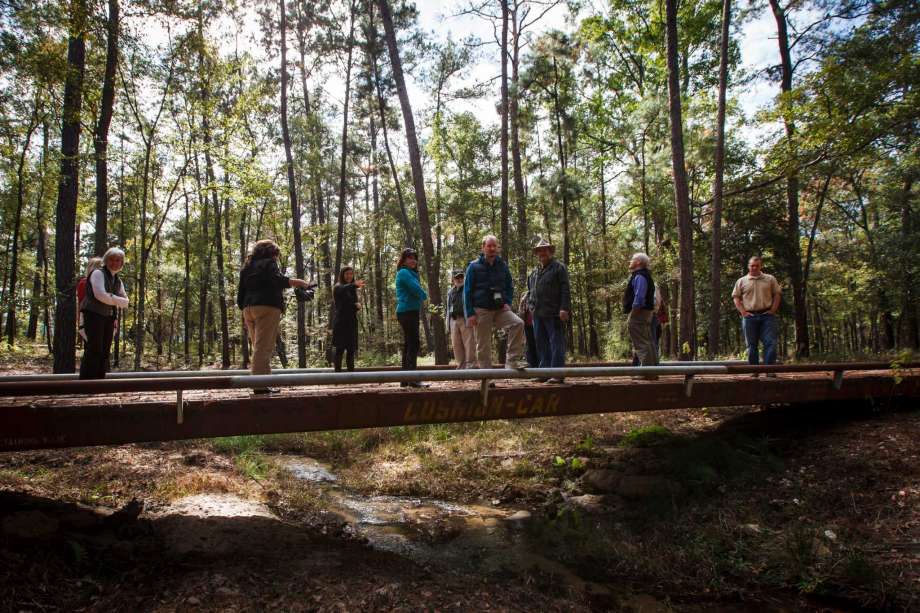Column: A valuable lesson on the birds and trees

This is a story about a family and its love for a plot of land. The fact that the 5,650 acre plot of land is owned by the family of oil-and-gas man, developer and dedicated philanthropist George P. Mitchell is just a matter of scale.
There are lessons in this story for everyone. Sarah Mitchell, a granddaughter of Mitchell and the late Cynthia Woods Mitchell, often refers to herself as "imprinted" on this land, known as Cook's Branch Conservancy. Now she is the executive director of the conservancy.
The western edge of the property, on FM 149, marks the very western edge of the East Texas Piney Woods. For nearly 50 years, this land has been the weekend retreat and more for the Mitchells and their 10 children, and now it is beloved by two newer generations of the family.
The stunning beauty of Cook's Branch Conservancy "This is an island at this point, but it is an example of what could have been, or might be, if other people get on board," says Sarah Mitchell.
By "island," she means this lovely land, with its free-flowing creek (the "branch" of the name), its three lakes, its field and forest, is virtually ringed by sprawl, not that the Mitchells use that s-word. But elsewhere, civilization has encroached on wildness, and wildness, as usual, is losing.
Which brings us to the other part of the story.
First we're going back a few years, to the mid-'60s when the Mitchells first bought the property. George Mitchell really loved the tall old loblolly and short-leaf pine trees, and, his daughter Sheridan Mitchell Lorenz says, he decided not to have any of the old trees cut down.
This was a crucial, and excellent, decision. It turns out there's an important resident of the forest whose life depends on the old trees: the red-cockaded woodpecker, a federally endangered bird.
Don't think Woody Woodpecker.
This is a smallish insect-eating bird with a small beak. Thus it takes great effort for the bird to bore its nesting holes into living trees. But pine trees 60 years and older tend to have red-heart fungus, which makes the "heart" of the trunk softer and easier to bore through. (People also sometimes help out, installing "inserts," or man-made cavities, in trees.)
Joe Hamrich, the project manager for Raven, a natural resource management company, explains the life of the red-cockaded woodpecker. "They are cooperative breeders," he says.
A couple lives not alone, but with at least one young male, usually a son from the previous year. He helps drill cavities and feed the young. Each family, plus the trees they live in, is called a "cluster." In the past decade, this land has gone from 13 to 23 clusters, the largest number on private land in Texas. "The trouble is, we're approaching capacity," says Sarah Mitchell.
The average size of a Cook's cluster is 3.1 birds, a very healthy number. In some other habitats, the size is close to 2, which makes the lives of the birds nearly impossible.
Sam Houston National Forest has 236 clusters, but there's no corridor linking the two habitats. With the cooperation of other landowners, however, the two could be connected. (This has already worked with wild turkeys.) Sarah Mitchell is quick to point out that all this effort is not about a single species. But it happens that what's good for the bird is good for the woods.
This land was once "forested grassland" - trees wide apart, little or no yaupon, native grasses covering the ground. Before the Mitchells started repairing the land, parts of it had been clear-cut as recently as 1916. Other parts were planted with non-native grasses tasty to cattle that overgrazed it. The forest areas were overgrown with too many trees and too much yaupon.
Slowly, through the family's restoration efforts, it is again forested grassland. Bobwhite quail have returned on their own. Theoretical physicist Stephen Hawking has been to Cook's Branch several times and loves it. So has naturalist Jane Goodall.
Sarah Mitchell is deeply moved that her entire family has voted unanimously to dedicate the property in perpetuity to preservation and restoration. "It will always be protected," she says.
This year, Cook's Branch won a Leopold Conservation Award, presented by the Sand County Foundation in partnership with Texas Parks and Wildlife. "It's really gratifying to be acknowledged for doing our best," says Sarah Mitchell.
Here's another interesting story about Cook's Branch, told by Sheridan Mitchell Lorenz. Cook's Branch was not the original name the Mitchells gave the land. The first name was chosen by one of the Mitchell children.
But when George Mitchell launched his dream of a big master-planned community, Cynthia Mitchell thought no name for it would do but the one given their Montgomery land. They asked for and received their child's permission to use the name. What was Cook's Branch's first name? The Woodlands.
This story was originally published in the Houston Chronicle.
For additional perspective on Cook's Branch Conservancy, click here:

NEWS
Hide Full Index
Show Full Index
View All News